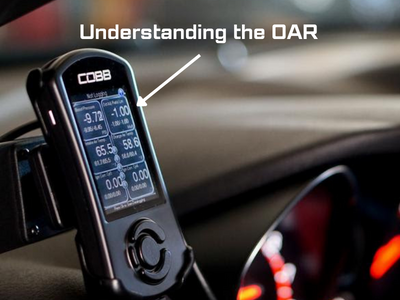Understanding Fords Octane Adjust Ratio (OAR)
This system causes quite a lot of confusion and even anxiety in the Ford tuning world.
This is simply because very few tuners leave it alone and let it do its job because they have no idea how it works or they are starting from someone else's firmware base that already has it neutered.
Its a really impressive system in my opinions so lets look into it a little deeper.
A little background on the system:
First of all, you need to understand that this is a FORD octane prediction and self tuning strategy. It has nothing whatsoever to do with COBB, with MSD, or with any other tuner. This strategy is proprietary Ford code and it has been in place on every car Ford have sold since at least 2012. We have been harnessing its power now for over 11 years and have never seen any need to disable it.
A little background on the system:
The PCM running your 2 and 2.3 litre Ecoboost engine is constantly listening to the noise that the engine makes. It has two little microphones called knock sensors that are tuned to your engines specific cylinder frequency and this noise data is fed back to the PCM constantly. The PCM actually knows the difference between an engine that is running well and one with poorly combusting fuel running into knock and it can adjust its spark and load allowance accordingly, per firing event, in order to combat the knocking fuel. This is the only system on the vehicle that stops you killing your engine with bad fuel.
All manufacturers cars now do this to some extent, but Fords recent strategies use this proprietary and patented OAR system as their solution and it is only this system we will discuss today..
How does it work? Is it not just the same as knock control?
No. The subsystem is the same, but the OAR strategy adds some much needed intelligence to the primitive knock control system.
ECU's have of course had knock control for tens of years, but simple knock control is quite flawed because if you run bad fuel constantly, the ECU is constantly having to retard to stop the bad knock because the system is only "reactive" meaning that it can only act AFTER a knock event was sensed. So the engine still knocks a lot if you are running a fuel that isn’t good enough for your current calibration. Every knock event adds a lot of heat and stress to the pistons, cylinders and bearings.
Whilst the traditional knock system should stop the engine being destroyed by a major single event of extreme knock, it doesn’t stop what we call "cumulative damage" which is the damage done by thousands of small knock events over a period of time that eat away at the ring lands etc.
So the manufacturers started to look for ways to enhance the standard knock control system. They wanted to come up with a way to determine what the octane of the fuel in the tank was likely to be and then recalibrate the spark and load maps "pro-actively".
In essence, they wanted a way to detect bad fuel and "De-Tune" the system with less advance and less load to make it more suitable for the poor fuel in the tank right now. This "pro-active" system would stop the constant knock and therefore avoid the cumulative damage that still afflicted older systems.
So how does it work?
The Ford solution is called an Octane Adjust Ratio (OAR) and the strategy controls access to three distinct load (think boost) limiting tables which we can for the sake of discussion call Low (93), medium (95) and high (97) octane tables. and an infinitely variable ignition system that reacts directly to the inferred octane and runs advance appropriate to the load table it is running in.
So, under very strictly controlled conditions the system will try to increase spark advance itself (Yes - This engine self tunes) in order to improve engine efficiency to the maximum your fuel will allow. More advance effectively reduces heat, improves fuel economy and lowers emissions, these are the O.E's main goals. As luck would have it for us enthusiasts, this also improves power.
As long as the engine responds positively to the advance added, with no knock, the strategy has proven that it currently has decent octane fuel and it moves towards its higher octane tables, unlocking both additional advance and additional cylinder load as a base. It then runs this new higher base setting and repeats the self tuning process periodically when certain criteria are met and it does so until such time as it has advanced to its full load and ignition tables 100%.
If the engine knocks badly at any time, it will move the other way, towards its low octane tables, thus lowering load and ignition advance allowance. It’s position between these blending tables is indicated by the OAR Figure which will be somewhere between a best of -1.00 (High-97) and a worst of +1.00 (Low-93) A middle position is an OAR of 0.00 (95)
So my ECU actually tunes itself for more spark advance and boost?
Yes, absolutely it does. It is an advanced form of adaptation and it also does this with fuel mixture, boost control and a few other system which i will write about in a future blog. Incidentally, the 2.3 strategy is significantly better at it than the earlier 2013 2litre ECU’s, but they all do it and we have incorporated some of the later strategies into the older Focus ST ECU calibrations to improve upon them.
It can take some time to fully adapt to your fuel as its looking for quite strict criteria in which to test your fuel octane. Also, some cars start out at 0.00 and others as high as 0.75. We typical dial you up to 0.80 on our performance tunes as we trust you to start off with quality fuel because you are an enthusiast and wouldn't use junk fuel... would you?
Note:
Because an ECU re-flash typically sets you back to an OAR of zero again, this feature is one of the reasons you have will all have heard things like... “She made 270ps on the dyno mate, but after you have driven it for a while it will make the 280”
Indeed, a strategy still utilising the load blending tables properly really WILL gain power as you drive.
So do I need to worry about this OAR system?
The bottom line here is no. Just use decent fuel and accept that the system will work just as it has worked on almost every Ecoboost on earth for 11+ years. If you are not running a handset that allows you to monitor this strategy and receive custom tuning based on its progress, then your interest in this strategy really ends here, just stick decent fuel in at all times and enjoy the fact that your ECU has this amazing capability.
It is a very impressive strategy that all tuners who understand Fords HDFX strategies should (Although sadly don’t) retain it. Interestingly, I heard of a US tuner recently promoting that he has the first ever Ford Focus Ecoboost tune that adapts to its fuel octane. Erm... as you now all know, it did it as standard and we have been tuning with it enabled since the cars rolled onto UK tarmac in 2012! But hundreds of tuners disabled it as they didn't understand what its for, or used another tuners base file that had it neutered. I guess these guys have re-enabled it. Quite rightly too!.

Why do people on forums seem to panic About OAR a lot then?
Ok, I am going to have to stick my head out here and say this is potentially my fault.
When we remote tune an Ecoboost on the awesome COBB Accessport platform, we refuse to add more power until the owner has got the OAR round to -1.00.
The Accessport has an amazing data-logger and can monitor hundreds of Ford parameters including not just OAR but its learning status so the owners can get deeply involved in learning how it all works. Unfortunately, people sometimes get really hung up on it, to the point of panic at times! They shouldn’t, but they do, and they tend to get upset when it doesn’t advance up to -1.00.
The fact is, if they didn’t have a COBB Accessport or some other way of monitoring the OAR status, even if the car was still standard, the OAR would have been the same, they just didn’t know about it. Too much information can be a bad thing...
So, why wont MSD tune the car unless the OAR is -1.00?
Hopefully, you have read and now understand that if the ECU is at lets say, -0.50, it still has a small reserve of both ignition advance and load (boost) to unlock for you when its ready. So, it would be unwise of me to add more ignition and boost to a system that hasn’t managed to tune itself up further yet, as this is indicating to me there "may" be an issue to investigate.
There is a chance that it hasn’t advanced to -1.00 because it is seeing knock, so its not a risk we will generally take without a little further investigation and, importantly, a conversation with the owner. We will go into more detail later...

What is the secret to fast track OAR adaptation?
Sometimes, the octane adjust ratio can just prove a little resistant to change because your driving style is a little too relaxed, or a little too hard, so I will let you into a secret. I know precisely when the ECU is going to try and adapt up your inferred octane numbers, so I can help you speed it up...
The key thing to know is that the ECU only adjusts the OAR during times the engine is LIKELY to knock but shouldn’t knock when using good fuel, so it doesn’t even try and adapt whilst cruising along a motorway as that’s an unlikely to knock situation, nor does it do anything much at wide open throttle as that is deemed as likely to knock anyway due to extreme stresses. Instead, it is looking for conditions where lean running and medium load will almost certainly cause knock on poor fuel.
The ECU is configured to actively try to adapt up under conditions as follows.
- Find a long road, ideally one that is slightly uphill.
- Select a quite high gear. (4th, 5th or 6th)
- Accelerate quite gently from 2000rpm at part throttle and around 3psi of boost
Thats it.
If the ECU manages to add the required allowance of advance to determine high octane fuel it will move your OAR towards the optimum value of -1.00. You may need to perform the above procedure a couple of times to get it all the way to -1.00, but it WILL work. If you really want to geek out, you can add "Oct Adj List Stat" to your monitors and you will see when it goes from 0 to 1 as the ecu identifies conditions that are likely to promote knock and starts testing your fuel by dialling in advance. You can of course also monitor the addition of advance with one of your ignition corrections channels.

What if it still doesn’t work. Or it goes the wrong way?
If that scenario above doesn’t work then we are probably looking at the knock sensor recording either real or ghost knock. Remember, this is the system doing its job. If it doesn’t dial it in, that’s because it has deemed it unsafe to do so, but it will default your ignition and load to levels it feels are safe and it is absolutely safe to drive your car as normal.
We are always on hand to advise our customers and can look at your logs and see what’s going on. Very commonly the system is just reacting to an engine bay or exhaust rattle fooling the sensors with what we call "Ghost Knock". Shiny engine bay add on's are common sources of bad resonance that cause just this. As are "uprated" engine mounts that are just too stiff. Sometimes of course its faulty knock sensors, over-tightening them usually kills them.
Regardless, these vehicles need some skilled intervention, NOT...more power!
**Disclaimer**
The above advice relates to FACTORY and MSD tunes only as many tuners disable all the LSPI limiters and octane adjust strategy and just poke max load figures in them all which effectively neuters the strategy so it runs the same load no matter where the OAR is positioned. A clue to this is that it dials into -1.00 almost immediately and doesn’t swing back the other way with heavy knock. Ask your own tuner for more details on their tunes strategies.
Author:
Stewart Sanderson - February 7th 2023







